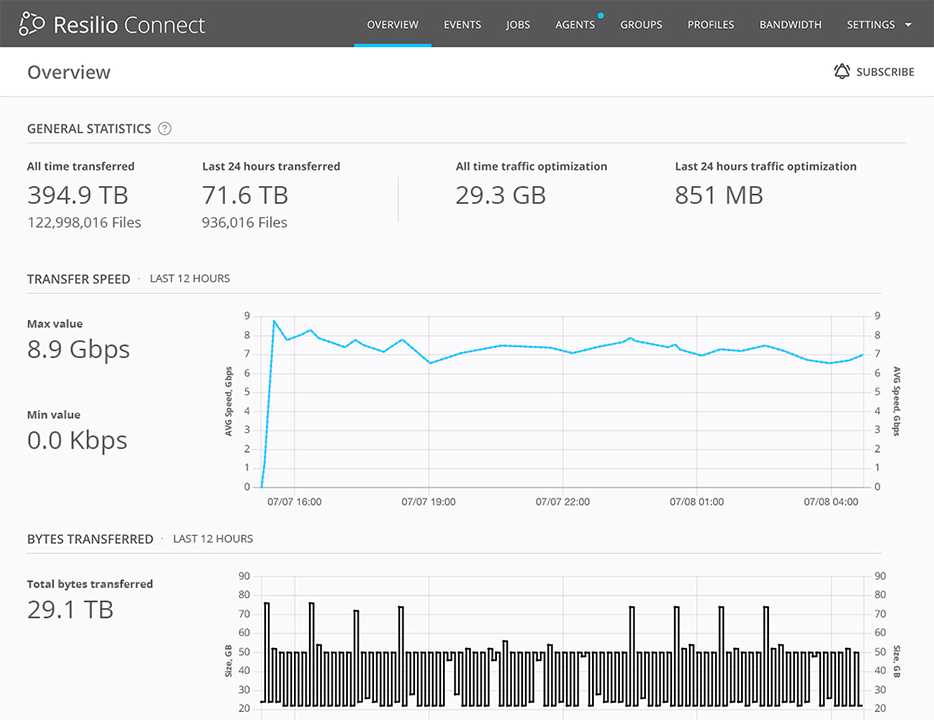Sync file servers with SharePoint to collaborate from anywhere
One request we’re hearing from customers is that they want to sync SharePoint with their file servers and other systems using Resilio Connect. Customers also tell us that storage performance matters. Customers appreciate the performance monitoring tools and sizing guidelines we’ve provided but also need guidance on storage performance.
Our latest release—Resilio Connect 3.8—includes an innovative kit of new and valuable capabilities. Resilio Connect now has storage performance counters for IOPS, storage payload simulation tools, API filters, scalability enhancements, licensing improvements—integration with Microsoft SharePoint Online—and more!
Introducing Resilio Connect for SharePoint Online
We’re excited to announce the availability of integration with Microsoft SharePoint online. Customers can now use Resilio Connect to sync SharePoint files and libraries with file servers, NAS, and other systems running Resilio agents. Another use case is extending collaboration to 3rd-party contributors—within and outside organizations. You can use Resilio Connect and SharePoint’s external file-sharing tools to collaborate with partner companies and internal teams or individuals.
To be clear, Resilio Connect is not replacing Microsoft OneDrive (or OneDrive Sync). Resilio Connect provides complementary technology separate from the OneDrive sync client.
Resilio makes syncing files between SharePoint Sites and local file servers easy and reliable. The solution scales to many millions of files of any size and type. It’s automated—to seamlessly sync files with SharePoint—and flexible. Resilio unifies popular file, block, and object storage.
There are several SharePoint use cases to consider:
- Sync between SharePoint and your file servers: Some customers may want to synchronize specific files and libraries stored in SharePoint with folders or subfolders on your file servers. In this scenario, Resilio enables an efficient two-way sync.
- Publish files to SharePoint: Some customers simply want to copy files in one direction (one-way) from their local file servers into SharePoint. The publishing process is reliable, automated, and optionally runs on a schedule.
- Ingest files from SharePoint: Collecting files from SharePoint is easy and automatic. For example, you might copy one set of files and libraries from SharePoint to a subfolder on one server—and another set to a different server. It’s easy to keep your local files and subfolders current with SharePoint.
- Protect and backup files on-premises: You can have a complete backup copy of your SharePoint files on-site or off-site. This option allows you to use any storage attached to a Resilio Connect agent—file, block, or object storage. Simply set up Resilio Connect to synchronize from SharePoint to your storage servers to protect as many files and libraries as needed on-premises.
- Offline access: Once files are stored on-site, you can work with files and folders without accessing SharePoint. Offline access is helpful in scenarios where there’s intermittent network connectivity. Resilio reliably and efficiently syncs files to SharePoint once reconnected to the network.
- 3rd-party File Sharing (send/receive): Collaborate within or outside your organization and with other teams. You can use SharePoint’s external file-sharing tools with Resilio Connect. You can extend access to your partner companies through SharePoint—and use Resilio Connect to sync files from SharePoint into your company’s domain. Or you can give your partners Resilio Connect to sync into SharePoint.
We think a popular scenario is to sync a SharePoint folder or subfolder with a local folder or subfolder stored on a file server. Another is complete backup on-premises. One Resilio customer envisions synchronizing SharePoint document libraries with their on-premises SAN-attached servers for redundancy and high availability as a near-line backup and restore.
There’s also the ability to use Resilio Connect as a file gateway to object storage. The storage can be on-premises or in any cloud (Azure, AWS, GCP, Wasabi, et al.). Users manage files and folders as they usually would in Windows File Explorer and Mac Finder.
To learn how to sync SharePoint with your file servers or discuss licensing options, please contact Resilio sales by scheduling a demo.
New Storage Performance Optimization Tools
Achieving holistic end-to-end performance depends on several factors, including storage performance. The actual transfer speed depends on multiple elements: network characteristics (bandwidth, latency, loss), CPU speed, memory capacity, and disk/SSD performance, measured in throughput and IOPS.
As expected, storage system performance varies. For example, a volume composed of SSDs from Vendor A may perform differently than Vendor B’s offering. One may do better with small block I/O and another better at large block sequential. Another consideration is the payload, measured in file sizes, number of files, directory layout, and block size to storage. The old adage “faster storage equates to better performance” may still hold. But much depends on matching the I/O to the payload.
But how do you measure and optimize storage performance for a given payload?
Resilio Connect now has an embedded tool to measure:
- Read speed
- Write speed
- IOPS
- Max, min, and average performance for each.
In addition, the new storage performance tool enables the administrator to simulate and test different payloads. As you can see below in the Select disk write test parameters screen, it’s easy to set custom parameters to simulate various storage payloads and determine the optimal configuration. You can set custom parameters for the number of files, file size, number of disk IO threads, and block size.
Buffering is an option to optimize for smaller files and small block payloads. This configurability and disk diagnostics help administrators optimize and tune the system for optimal performance.
Advancing Automation: API Scalability and New Filters
Workflow automation is critical to many Resilio Customers. The REST API covers 100% of the product functionality and allows for configuration and monitoring of the product.
Resilio Connect 3.8 improves the API’s scalability and adds new API filters. One advancement is that API requests are rate-limited to maintain performance during high-volume API requests. As more customers adopt and integrate the API, scalability is critical. The new API filters simplify managing thousands of concurrent Jobs.
New API filters include:
- Name wildcard (e.g., “dist_a*”)
- Is active? – only get active or inactive jobs
- Ever ran? – only get jobs that never ran or ran at least once
Resilio also makes it possible to delete a list of Jobs in a single API call.
Licensing Updates for Improved Visibility
Customer success is essential to Resilio. Licensed capabilities should be easy to track and view. In 3.8, Resilio simplified the licensing screens to make it easier for you to:
- See which features you’ve licensed
- View your current support plan
- View your current usage
- Request additional agents or other licensed features.
The License administration screen below demonstrates the new user interface.
We also added the ability to trial new functionality quickly. Suppose you want to try a new feature, upgrade agent performance, or order more agents. In that case, you can submit a request directly from the management console—and Resilio will quickly issue a trial package.
What Customers Are Doing
Resilio is proud to have the most data-driven customers in the world. In a recent conversation with Emanuele Guidolin, head of IT at Maffeis Engineering, we discussed their engineering process. Maffeis uses many Autodesk products, which generate many calculation result files. Guidolin says each file is about 2 GB, and each project contains about 200 to 2,000 files. Some projects reach 2 TBs of total data.
“When a change is made to the design, we need those changes immediately available to everyone across all sites—at the same time. Engineering uses design models to calculate and control if the building stays up or down. If someone makes a decision based on inaccurate information, it could be catastrophic—impacting all of our projects.”
Thanks to Resilio, he says the Maffeis team achieves their required performance goals to collaborate concurrently on the same file across sites. He says the speed of Resilio—combined with near real-time collaboration across sites—is a big win for Maffeis.
Getting Started with Resilio Connect
If you’re new to Resilio, we’d love to hear from you. Please click here to schedule a demo with our team. If you’re a Resilio customer considering an upgrade or want to learn more about what’s coming next, please schedule time with our customer success manager, Carolina Ibarra, to obtain the latest version of Resilio Connect.






